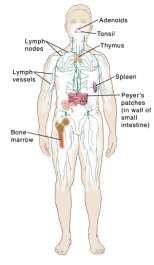Allergies and the Immune System
Allergic disease is one of the most common chronic health conditions in the world. People with a family history of allergies have an increased risk of developing allergic disease. Hay fever, eczema, hives, asthma, and food allergy are some types of allergic diseases. Allergy symptoms can range from mild to a serious, life-threatening allergic reaction (anaphylaxis).
Allergic reactions begin in your immune system. When a harmless substance such as dust, mold, or pollen is encountered by a person who is allergic to that substance, the immune system may overreact. It may produce antibodies that attack the allergen. These can cause wheezing, itching, runny nose, watery or itchy eyes, and other symptoms.
What is the immune system?
The purpose of the immune system is to defend itself and keep microorganisms, such as certain bacteria, viruses, and fungi, out of the body. It also destroys any infectious microorganisms that do invade the body. The immune system is made up of a complex and vital network of cells and organs that protect the body from infection.
The immune system is made up of a complex and vital network of cells and organs that protect the body from infection.
The organs involved with the immune system are called the lymphoid organs. They affect growth, development, and the release of certain white blood cells called lymphocytes. The blood vessels and lymphatic vessels are important parts of the lymphoid organs. They carry the lymphocytes to and from different areas in the body. Each lymphoid organ plays a role in the production and activation of lymphocytes.
Lymphoid organs include:
Adenoids (2 glands located at the back of the nasal passages)
Appendix (a small tube that is connected to the large intestine)
Blood vessels (the arteries, veins, and capillaries through which blood flows)
Bone marrow (the soft, fatty tissue found in bone cavities)
Lymph nodes (small organs shaped like beans, which are located throughout the body and connect via the lymphatic vessels)
Lymphatic vessels (a network of channels throughout the body that carries lymphocytes to the lymphoid organs and bloodstream)
Peyer's patches (lymphoid tissue in the small intestine)
Spleen (a fist-sized organ located in the abdominal cavity)
Thymus (2 lobes that join in front of the trachea behind the breast bone)
Tonsils (2 oval masses in the back of the throat)
How does a person become allergic?
Allergens can be inhaled, ingested, or enter through the skin. Common allergic reactions, such as hay fever, certain types of asthma, and hives are linked to an antibody produced by the body called immunoglobulin E (IgE). Each IgE antibody can be very specific, reacting against certain pollens and other allergens. In other words, a person can be allergic to one type of pollen, but not another. When a susceptible person is exposed to an allergen, the body starts producing a large quantity of similar IgE antibodies. The next exposure to the same allergen may result in an allergic reaction. Symptoms of an allergic reaction will vary depending on the type and amount of allergen encountered and how the body's immune system reacts to that allergen.
Allergies can affect anyone, regardless of age, gender, race, or socioeconomic status. Generally, allergies are more common in children. But a first-time occurrence can happen at any age. Or it can come back after many years of remission. Hormones, stress, smoke, perfume, or environmental irritants may also play a role in the development or severity of allergies.
What is anaphylactic shock?
Anaphylactic shock, also called anaphylaxis, is a severe, life-threatening reaction to certain allergens. Body tissues may swell, including tissues in the throat. There is also a sudden drop in blood pressure. The following are the most common symptoms of anaphylactic shock. But each person may experience symptoms differently. Other symptoms may include:
Itching and hives over most of the body
Feeling warm
Swelling of the throat and tongue or tightness in throat
Trouble breathing or shortness of breath
Dizziness
Headache
Pain or cramps
Nausea, vomiting, or diarrhea
Shock
Loss of consciousness
Feeling light-headed
Anxiety
Abnormal heart rate (too fast or too slow)
Anaphylactic shock can be caused by an allergic reaction to a medicine, food, serum, insect venom, allergen extract, or chemical. Some people who are aware of their allergic reactions or allergens carry an emergency anaphylaxis kit that contains injectable epinephrine. This is a medicine that stimulates the adrenal glands and increases the rate and force of the heartbeat.

Connect with us:
Download our App: